The NASA Electronic Parts and Packaging (NEPP) '02 Workshop
The NASA Electronic Parts and Packaging (NEPP) '02 Workshop
The NASA Electronic Parts and Packaging (NEPP) '02 Workshop
You also want an ePaper? Increase the reach of your titles
YUMPU automatically turns print PDFs into web optimized ePapers that Google loves.
Abstracts ________________________<br />
Session 4 – Innovative Qualification <strong>and</strong> Test<br />
Methods<br />
Fiber Optic Cable Assembly Characterization Studies at <strong>NASA</strong><br />
Goddard Space Flight Center<br />
Melanie N. Ott<br />
Sigma Research <strong>and</strong> Engineering / <strong>NASA</strong> Goddard Space Flight<br />
Center<br />
Component Technologies <strong>and</strong> Radiation Effects Branch<br />
Melanie.ott@gsfc.nasa.gov<br />
301-286-0127<br />
Abstract<br />
In the past, space flight specifications for optical fiber cable<br />
assemblies required a long list of qualification tests. Since the<br />
usage of commercial products became an acceptable practice <strong>and</strong><br />
a necessity for space flight, this long list of qualification testing<br />
became impractical. This was due to the vast time consumption<br />
<strong>and</strong> high cost expenditures for vendors <strong>and</strong> space flight projects to<br />
perform these testing plans each time that a part or process was<br />
changed or an alternative design was necessary. This change in<br />
scope <strong>and</strong> the advances in fiber optic technologies required more<br />
focus be placed on the methods by which cable assemblies were<br />
characterized. <strong>The</strong> goal was to identify new test plans that could be<br />
used to bring out failure modes of the parts <strong>and</strong> packaging but with<br />
fewer required tests, of less duration. In the past five years, the<br />
GSFC Technology Validation Assurance Laboratory for Photonics<br />
has focused on this issue for <strong>NEPP</strong>. A thorough investigation was<br />
conducted on failure modes <strong>and</strong> testing to advance aging on<br />
optical fiber assemblies.[1] <strong>The</strong> objective was to eliminate<br />
unnecessary testing that had become entrenched in the<br />
specification process through heritage but that did not necessarily<br />
provide reliability information specific to space flight environments.<br />
<strong>The</strong> result of this study allowed for new test plans to be formulated.<br />
<strong>The</strong>se test plans have been used to validate several types of cable<br />
assembly technologies that were not previously available for space<br />
flight.[2-6] Other heritage technologies have been made obsolete<br />
as the study uncovered failure modes that now could be identified<br />
more readily through innovative characterization test methods.[2,4]<br />
This presentation will provide a summary, with recent examples, of<br />
the effort to provide innovative characterization plans that minimize<br />
cost but allow for reliability assessments on commercial optical<br />
fiber cable assemblies for space flight environments.<br />
1. Melanie Ott, Jeannette Plante, Fiber Optic Cable<br />
Assemblies for Space Flight Applications: Issues <strong>and</strong><br />
Remedies, SAE/AIAA publication, World Aviation<br />
Congress, October 1997.<br />
2. Melanie Ott, Fiber Optic Cable Assemblies for Space<br />
Flight II: <strong>The</strong>rmal <strong>and</strong> Radiation Effects, :July 1998, SPIE<br />
Proceedings Vol. 3440 Photonics for Space<br />
Environments.<br />
3. Melanie Ott, Joy Bretthauer , Twelve Channel Optical<br />
Fiber Connector Assembly: From Commercial off the<br />
Shelf to Space Flight Use, July 1998, SPIE Vol. 3440<br />
Photonics for Space Environments.<br />
4. Melanie Ott, Patricia Friedberg, Technology Validation of<br />
Optical Fiber Cables for Space Flight Environments,<br />
SPIE Proceedings Vol. 4216, Optical Devices for Fiber<br />
Communication II, Conference November 8, 2000.<br />
15<br />
5. Matthew Bettencourt, Melanie Ott, Fiber Optic Epoxy<br />
Outgassing Study for Space Flight Applications , <strong>NEPP</strong><br />
Web Publication, October 4, 2001.<br />
6. Melanie Ott, Shawn Macmurphy, Patricia Friedberg,<br />
Characterization of a twelve channel optical fiber, ribbon<br />
cable <strong>and</strong> MTP array connector assembly for space flight<br />
environments, SPIE Proceedings Vol. 4732, Enabling<br />
Photonic Technologies for Aerospace <strong>and</strong> Applications<br />
IV, 2002.<br />
Speaker Biography<br />
Melanie N. Ott is a Principal electrical systems engineer from<br />
Sigma Research <strong>and</strong> Engineering <strong>and</strong> functions as the Director of<br />
the photonics laboratories for the Component Technologies <strong>and</strong><br />
Radiation Effects Branch at <strong>NASA</strong> Goddard Space Flight Center.<br />
Under her leadership, the laboratories support <strong>NASA</strong> projects from<br />
design to integration <strong>and</strong> testing for applications of photonic<br />
systems for communications, LIDAR <strong>and</strong> sensing systems. She<br />
has published thirty seven papers, articles <strong>and</strong> presentations on<br />
the subject of photonics for space flight most of which are available<br />
on the Code 562 photonics website. For <strong>NEPP</strong>, Ott has focused on<br />
the reliability of fiber optic <strong>and</strong> photonic component packaging <strong>and</strong><br />
parts for the past seven years.<br />
Ott holds a Masters in Electrical Engineering with Optics emphasis<br />
from Virginia Polytechnic Institute <strong>and</strong> State University. Prior to<br />
working at GSFC she worked at <strong>NASA</strong> Langley Research Center,<br />
the Fiber <strong>and</strong> Electro Optics Research Center (FEORC) in<br />
Blacksburg Virginia <strong>and</strong> the Crystal Physics Laboratory at the<br />
Massachusetts Institute of Technology.<br />
Rapid Qualification of Area Array Package Assemblies by<br />
Increase of Ramp Rates <strong>and</strong> Temperature Ranges<br />
Reza Ghaffarian<br />
Jet Propulsion Laboratory, California Institute of Technology ,<br />
Pasadena, CA<br />
Reza.Ghaffrian@JPL.<strong>NASA</strong>.Gov, (818) 354-2059<br />
Abstract<br />
Advanced area array packaging, including brought about new<br />
package technology including materials <strong>and</strong> processes as well new<br />
applications with environmental requirements not seen in their<br />
previous generation. Rapid insertion of electronics packaging<br />
technology necessitates faster qualification implementation <strong>and</strong><br />
therefore development of accelerated test methods. Increase of<br />
ramp rate up to 20°C/min is allowed in a recently released<br />
specification, IPC 9701, “Performance Test Methods <strong>and</strong><br />
Qualification Requirements for Surface Mount Solder<br />
Attachments”.<br />
Accelerated thermal cycling with a large temperature swing can be<br />
used as an environmental screening test <strong>and</strong> often has been<br />
considered as a qualification requirement for harsh environmental<br />
applications. <strong>The</strong>re are many concerns, however, when such<br />
accelerations are performed especially for electronics packages<br />
with no environmental testing heritage. <strong>The</strong>se concerns include:<br />
the effects of cold <strong>and</strong> hot temperatures in a cycle range, time <strong>and</strong><br />
temperature at dwells, temperature exposure to higher than 110°C<br />
for eutectic solder, <strong>and</strong> the effects of heating/cooling rates.<br />
A JPL-led chip scale package (CSP) Consortium of enterprises,<br />
composed of team members representing government agencies<br />
<strong>and</strong> private companies, have joined together to pool in-kind<br />
resources for developing the quality <strong>and</strong> reliability of chip scale


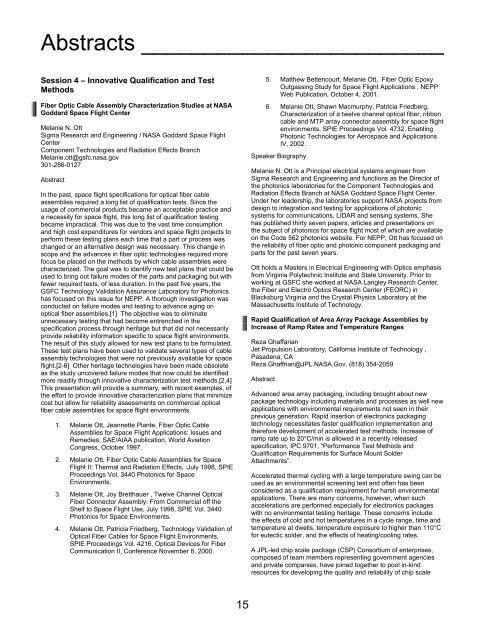
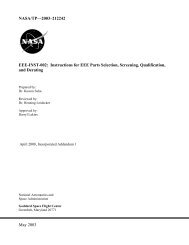

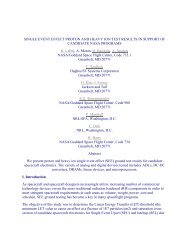
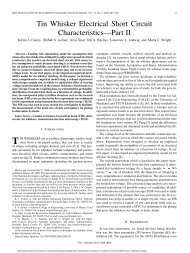
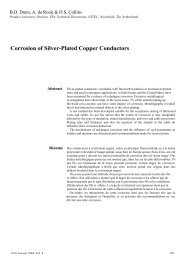
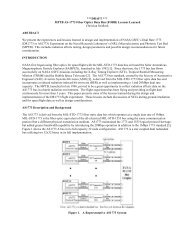

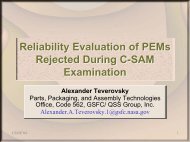
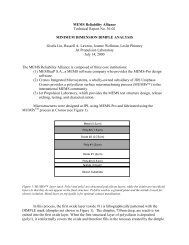
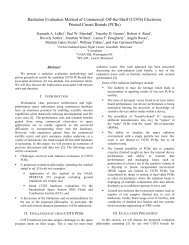
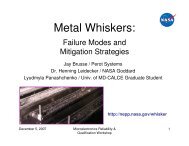
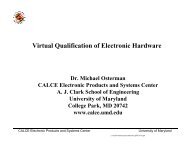
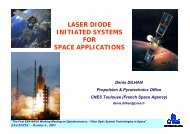
![mil-std-2223 [test methods for insulated electric wire] - NEPP](https://img.yumpu.com/4036001/1/190x249/mil-std-2223-test-methods-for-insulated-electric-wire-nepp.jpg?quality=85)